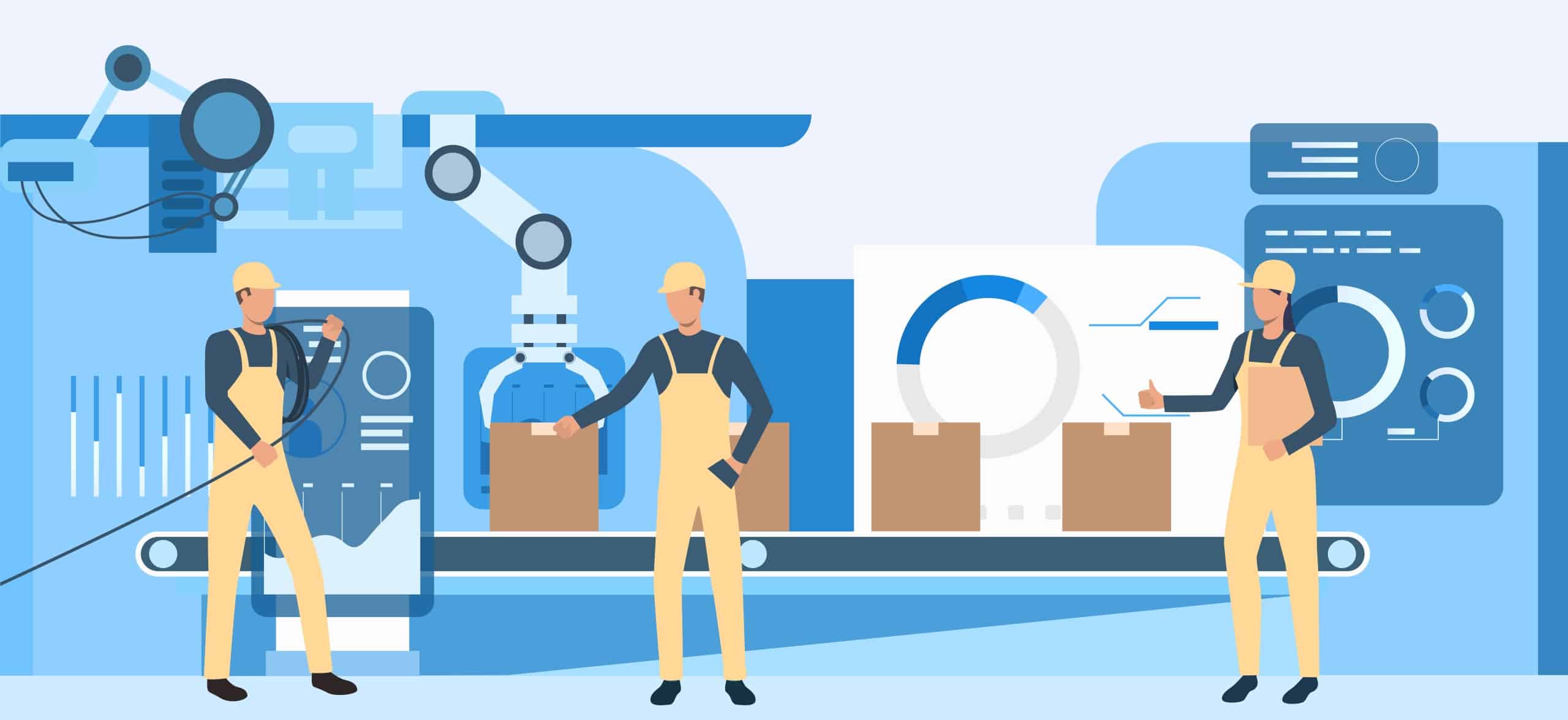1. Integration of IoT and Smart Sensors
The incorporation of the Internet of Things (IoT) and intelligent sensors is a transformative development for the wet wipes production sector. Wet wipes manufacturers may reach unparalleled levels of real-time monitoring and control by incorporating IoT-enabled devices and intelligent sensors throughout manufacturing. These technologies enable the ongoing gathering of data from several wet wipes manufacturing process phases, providing valuable information on wet wipes machine efficiency, production rates, and product quality. Using this data, wet wipes manufacturers may use predictive maintenance procedures, enabling them to anticipate equipment breakdowns in advance and schedule repair during periods of low demand. By adopting this proactive strategy, the amount of time during which operations are suspended is minimized, the expenses associated with maintenance are decreased, and the production line is guaranteed to function at its highest level of efficiency.
In addition, intelligent sensors can identify even the most minor variations in the manufacturing factors, such as temperature, humidity, and pressure, which are crucial for ensuring the high quality of wet wipes. If a sensor detects a change in humidity levels that may impact the moisture content of the wipes, the system may automatically modify the settings to ensure uniformity. Such a high degree of accuracy is crucial for upholding tight quality control standards, minimizing waste, and guaranteeing that each wipe satisfies the necessary specifications before being sent to the user.
Moreover, the data gathered by IoT and intelligent sensors may be scrutinized to discern previously imperceptible patterns and trends. Wet wipes manufacturers may use these observations to optimize wet wipes manufacturing processes, boost resource allocation, and enhance overall operational efficiency. By doing data analysis, a manufacturer may identify a pattern where a certain machine tends to overheat at specific time intervals. Armed with this information, individuals may implement measures to tackle the problem, such as modifying the machine’s operational timetable or improving its cooling mechanism. The integration of IoT and smart sensors enables producers to make data-driven choices that promote productivity, decrease expenses, and enhance product quality, therefore establishing a new benchmark for the wet wipes business.
2. Advanced Robotics and AI
The integration of sophisticated robotics and artificial intelligence (AI) in the manufacturing of wet wipes is revolutionizing the sector by automating monotonous operations and enhancing operational effectiveness. Robots that are outfitted with artificial intelligence (AI) skills can carry out a diverse array of tasks, including but not limited to material handling, assembly, packing, and quality control. These robots are engineered to operate with exceptional accuracy and velocity, resulting in a substantial decrease in the duration and manpower needed for each production cycle. Robots alleviate human workers from repetitive and labor-intensive chores, enabling them to concentrate on more intricate and value-enhancing activities, resulting in a more efficient and productive workforce.
AI-driven robots enhance the manufacturing process by adding an extra level of intelligence. Using machine learning algorithms, these robots are capable of analyzing data, acquiring knowledge from it, and enhancing their performance progressively. For instance, in a wet wipes manufacturing facility, artificial intelligence robots can modify their actions according to immediate input. Should a robot identify any discrepancy in the dimensions or form of a wipe, it may autonomously readjust its operations to rectify the problem, therefore guaranteeing a uniform standard of product quality. The capacity to adapt is especially advantageous in a manufacturing setting, where there is a high likelihood of rapid changes in product specifications and production needs.
Moreover, artificial intelligence and robots improve the potential to increase the size and adaptability of wet wipes manufacturing. To keep up with changing customer tastes and the growing demand for various kinds of wet wipes, wet wipes manufacturers must possess the ability to swiftly adjust their manufacturing processes. The combination of advanced robots and AI enables fast modification of industrial processes. AI-driven robots can smoothly transition between different product lines, adapt packaging formats, and adopt new quality control measures, ensuring minimal downtime and maximum output. This adaptability guarantees that wet wipes manufacturers can maintain their competitiveness and promptly adapt to market fluctuations.
Integrating robots and AI offers a notable benefit of enhancing safety and ergonomics in the manufacturing environment. Robots are capable of managing hazardous or physically strenuous assignments, hence reducing the likelihood of harm to human laborers. This not only promotes a more secure work environment but also improves overall operational effectiveness by reducing the interruptions caused by workplace incidents. Furthermore, by using AI systems that consistently monitor and optimize manufacturing processes, wet wipes manufacturers may get elevated levels of accuracy and uniformity, leading to less waste and decreased production expenses.
Ultimately, the use of sophisticated robotics and artificial intelligence in the manufacture of wet wipes signifies a significant advancement in manufacturing technology. Through the automation of repetitive operations, enhancement of flexibility, and improvement of safety measures, these technologies empower wet wipes manufacturers to enhance productivity, minimize expenses, and uphold stringent product quality requirements. As the industry progresses, robots and AI will surely play a more crucial role, leading to additional improvements and establishing new standards of excellence in wet wipes manufacturing.
3. Automated Quality Control Systems
Automated quality control solutions are transforming the wet wipes production business by guaranteeing constant product quality and substantially minimizing waste. These systems use cutting-edge technology like high-resolution cameras, sensors, and AI-powered image recognition to examine each wet wipe as it progresses down the manufacturing line. The capacity to check in real-time enables the instant discovery of problems, such as wrong measurements, rips, or uneven moisture distribution, that may not be readily identifiable via human examination. By identifying these problems at an early stage of manufacturing, firms may avoid the distribution of faulty items, therefore safeguarding their brand image and minimizing the expenses linked to product recalls.
An important benefit of automated quality control systems is their capacity to function at high velocities while maintaining precision. Conventional manual inspection techniques may be time-consuming and susceptible to human mistakes, particularly when handling large quantities of items. Automated systems, however, can examine thousands of wipes each minute with a degree of accuracy that exceeds human capabilities. This not only enhances the efficiency of the manufacturing line but also guarantees that each wipe adheres to the prescribed quality criteria. The outcome is an enhanced and streamlined manufacturing process that can effectively meet the substantial demand for wet wipes, even during periods of heightened consumer need.
Moreover, these automated systems may be configured to comply with precise quality standards, enabling the implementation of tailored quality control processes. Wet wipes manufacturers can establish customized parameters depending on their product requirements, including precise measurements, weight, and moisture levels necessary for each kind of wet wipe. The automated system then utilizes these data to assess each product, guaranteeing uniformity and adherence to the specified requirements. The amount of personalization provided is especially advantageous for wet wipes manufacturers that produce a range of wet wipes, since it enables them to maintain consistent high-quality standards across various product lines.
Automated quality control systems provide a notable advantage in terms of their ability to gather and analyze data thoroughly. Every inspection produces useful data that may be used to detect trends and patterns in the wet wipes manufacturing process. For example, if a certain kind of flaw is identified with more frequency during a specific phase of manufacturing, this data may assist in identifying the underlying source of the issue. Subsequently, wet wipes manufacturers can implement remedial measures, such as modifying machine configurations or enhancing the quality of raw materials, to resolve the problem. Over time, the iterative process of continuous improvement results in improved product quality and less waste, hence enhancing total operating efficiency.
Automated quality control systems not only boost product quality and efficiency but also improve compliance with regulatory norms. The wet wipes sector is governed by rigorous standards about the safety and quality of their products. Automated systems give comprehensive documentation of every inspection, providing a clear and verifiable path of compliance. This not only streamlines the process of fulfilling regulatory obligations but also enhances the manufacturer’s capacity to showcase adherence to customers and stakeholders.
To summarize, automated quality control systems are a revolutionary technology in the wet wipes production business. These systems increase product quality, minimize waste, and promote operational efficiency by conducting high-speed and precise inspections of every product. Their capacity to provide tailored quality control techniques and significant data insights also reinforces ongoing enhancement and adherence to regulations. To stay ahead in the market and provide clients with top-notch goods, wet wipes manufacturers must embrace automated quality control systems as an indispensable tool in the face of ongoing changes.
4. Sustainable and Eco-Friendly Automation
The need to use sustainable and environmentally-friendly procedures in the manufacture of wet wipes is growing in importance due to the rising demand from customers and regulatory organizations. The use of sustainable and eco-friendly automation in industrial processes effectively mitigates the environmental impact and encourages responsible utilization of resources. This transition not only brings advantages for the environment but also enables enterprises to conform to customer expectations and regulatory mandates, possibly resulting in increased market acceptability and brand loyalty.
Energy efficiency is a key aspect in which automation helps sustainability. Automated systems are designed to enhance energy efficiency by activating machinery only when required and at the most efficient levels. Advanced automation may be used to plan manufacturing runs during times of reduced energy demand or to use renewable energy sources. In addition, the use of energy-efficient equipment and technology, such as variable speed drives and automatic shut-off systems, serves to further diminish energy consumption, hence decreasing the total carbon footprint associated with the wet wipes manufacturing process. Implementing these energy-saving solutions not only helps in preserving the environment but also leads to substantial financial savings for industries.
Another crucial element of sustainable automation is the minimization of waste. Automated systems improve accuracy and regulate the manufacturing process, reducing the amount of wasted materials. Advanced sensors and AI algorithms can precisely measure and distribute raw resources, guaranteeing little wastage. This level of accuracy minimizes waste and the production of substandard goods, resulting in a more effective use of resources. Moreover, automation enables the integration of recycling procedures into the manufacturing line. Systems may be configured to detect and separate waste items for recycling, hence decreasing the amount of garbage that is disposed of in landfills.
Water conservation is a notable issue in the manufacture of wet wipes, since water plays a crucial role as a component. Automated water management systems can oversee and regulate water use at every stage of the industrial process, guaranteeing optimal utilization. Advanced technologies, such as closed-loop water recycling systems, enable industries to reuse water many times before the requirement for treatment and release. This practice not only helps to save water but also reduces the environmental consequences linked to the treatment and disposal of wastewater. In areas experiencing water shortages, these technologies are very important and may improve the sustainability of the production plant.
Incorporating environmentally-friendly materials is a crucial component of sustainable automation. Automated manufacturing lines may be modified to include biodegradable and compostable materials, by the increasing need for eco-friendly goods. Automation may be used to accurately regulate the composition and implementation of natural fibers and biodegradable solutions in wet wipes, guaranteeing uniform quality and effectiveness. Wet wipes manufacturers may diminish their dependence on non-renewable resources and mitigate the environmental consequences of their goods by using sustainable materials.
Automation also facilitates the development and execution of environmentally-friendly packaging solutions. Automated packaging lines can effectively manage environmentally friendly packaging materials, such as recycled paper and biodegradable plastics while maintaining the speed and precision of the packaging process. These systems may be designed to optimize package design, hence lowering material use and eliminating waste. Adopting sustainable packaging not only decreases the negative impact on the environment but also attracts environmentally aware customers, hence improving the marketability of the product.
Furthermore, the data produced by automated systems may be used to further sustainability initiatives. Comprehensive analysis of energy use, material usage, and waste creation enables wet wipes manufacturers to pinpoint areas that need improvement and carry out specific sustainability activities. Continuous monitoring and data analysis enables the continual refinement of the manufacturing process, guaranteeing the achievement and preservation of sustainability objectives in the long run.
Ultimately, the wet wipes production business is being revolutionized by sustainable and environmentally conscious automation. This technology encourages the responsible use of resources, minimizes the negative effects on the environment, and complies with the expectations of both consumers and regulatory bodies. Automation is aiding businesses in achieving their sustainability goals by implementing energy-efficient practices, reducing waste, conserving water, using eco-friendly products, and adopting sustainable packaging. To stay ahead in the business and promote a more sustainable future, it is essential to include sustainable practices in automated systems as the sector progresses.
5. Customization and Flexibility
In the dynamic wet wipes manufacturing business, the capacity to personalize goods and swiftly adjust to changing customer preferences is essential. Automation is crucial in delivering the required personalization and adaptability to fulfill these expectations. Contemporary automated systems are designed to possess great flexibility, enabling wet wipes manufacturers to generate a diverse range of wet wipes with various specifications, package styles, and compositions effectively. This adaptability not only assists in meeting the varied requirements of customers but also improves the capacity to create and promptly produce new items.
An important advantage of automation in customizing is the capacity to swiftly transition between several product lines without substantial periods of inactivity. Wet wipes manufacturers may readily alter production lines using programmable logic controllers (PLCs) and modular automation systems. As an example, a solitary manufacturing line might be modified to manufacture baby wipes, disinfection wipes, and cosmetic wipes by just altering the parameters established in the automated system. The capacity to adapt allows wet wipes manufacturers to quickly react to market developments and customer expectations, therefore staying ahead of competitors in the sector.
Additionally, automated systems provide meticulous regulation of diverse manufacturing factors, facilitating the development of exceptionally tailored items. Wet wipes manufacturers can modify variables such as the thickness, texture, and moisture content of the wipes to fulfill specified criteria. Precision dosing systems can dispense various formulas with accuracy, guaranteeing that each wet wipe includes the precise chemicals required for its specific purpose. Such a high degree of accuracy guarantees uniform quality in every batch, which is crucial for establishing customer confidence and contentment.
Automation further enables the tailoring of packaging. Automated packaging machines can process a wide range of packaging designs, including both small single-use sachets and larger bulk packages. These wet wipes machines may also be equipped with additional features like resealable caps or easy-open tabs. Wet wipes manufacturers may adapt to various customer preferences and use cases due to the flexibility in packaging. For example, compact packs may be manufactured for easy portability, while larger, economy-sized packs can be provided for usage at home. Moreover, automated systems have the potential to promptly adjust to novel package designs or materials, hence promoting sustainability efforts via the integration of environmentally acceptable packaging alternatives.
Automation in customization offers the notable benefit of effectively producing limited-edition or seasonal items. Wet wipes manufacturers may efficiently incorporate modifications to the manufacturing line for limited quantities of specialized items using automated technologies. This feature is especially advantageous when it comes to meeting temporary needs, such as manufacturing wipes with specialized scents or package designs for holidays or special occasions. Wet wipes manufacturers may generate customer attention and boost sales by providing distinctive and time-limited items, which create a feeling of urgency and exclusivity.
Flexibility in manufacturing also includes the capacity to increase or decrease in size according to demand. Automated systems can modify production rates and capacities to match the prevailing market circumstances. Automated production lines may be scaled up during moments of high demand, such as during a public health crisis or a seasonal spike, to satisfy the heightened need for wet wipes. In contrast, during times of less activity, output might be reduced to prevent overproduction and excessive inventory. The capacity to scale means that producers can retain operational efficiency and cost-effectiveness regardless of changing market circumstances.
Moreover, the incorporation of data analytics into automated systems improves the ability to tailor and adapt. Wet wipes manufacturers may get valuable insights into product creation and optimization by examining production data, which allows them to detect trends and patterns. For example, data analysis may uncover that a given population has a strong preference for a particular formulation or package design. Equipped with this knowledge, wet wipes manufacturers may customize their goods to more effectively cater to the tastes of their intended consumers, therefore enhancing customer happiness and fostering loyalty.
To summarize, automation greatly improves the ability to customize and adapt the manufacture of wet wipes. Automated systems provide wet wipes manufacturers with the ability to make rapid changes to production lines, maintain exact control over product specifications, provide flexible packaging choices, efficiently produce limited-edition goods, and scale their output. This enables manufacturers to remain adaptable and responsive in a constantly changing market. Data analytics integration enhances decision-making and continuous improvement, enabling businesses to continually provide high-quality, personalized goods that match the changing demands of customers.
6. Remote Monitoring and Control
The wet wipes manufacturing sector is being revolutionized by remote monitoring and control, which allows wet wipes manufacturers to have unparalleled access to their production processes from any location. Remote monitoring, made possible by improvements in cloud computing, IoT, and secure connection, enables wet wipes manufacturers to supervise operations, maintain optimal performance, and promptly resolve problems in real-time, without the need for human presence at the production site. This feature is especially advantageous in the current international market, as production facilities may be distributed across several regions or nations.
An important advantage of remote monitoring and control is the capacity to improve operational efficiency. Managers may rapidly make well-informed choices by using a single dashboard that provides real-time data on production metrics, equipment conditions, and process parameters. For example, when a wet wipes machine’s performance falls below the ideal levels, remote monitoring systems may notify operators about possible difficulties before they become significant problems. This proactive strategy reduces the amount of time when operations are not operating and ensures that the production line operates efficiently. Moreover, the ability to manage remotely enables prompt modifications to the manufacturing process, guaranteeing uniform product quality and minimizing waste.
Another notable benefit is the enhancement of maintenance procedures. Remote monitoring systems provide the capability to continually monitor and assess the condition and performance of machines. Through the analysis of this data, wet wipes manufacturers may use predictive maintenance procedures, enabling them to anticipate equipment failures and schedule repair at optimal periods. This minimizes the development of unforeseen malfunctions and prolongs the durability of the equipment. In addition, remote diagnostics allow technicians to identify and address issues from a distant location, offering direction to on-site workers or fixing problems directly via remote interventions. This minimizes the need for expensive and time-consuming on-site inspections.
One of the main advantages of remote monitoring and control is the capacity to supervise various facilities from a centralized location. Wet wipes manufacturers that have many production locations often face the challenge of managing operations in a complicated and resource-intensive manner. Remote monitoring solutions integrate data from several sites into a single platform, enabling managers to analyze performance indicators, discover optimal strategies, and adopt uniform processes across all locations. By adopting a holistic perspective, it becomes possible to effectively coordinate and optimize operations, guaranteeing that all facilities function at their highest level of efficiency and maintain consistent quality standards.
Remote monitoring and control not only provide operational advantages but also boost security and compliance. Contemporary remote monitoring systems are equipped with strong cybersecurity protections to safeguard important production data from illegal access and cyber threats. Wet wipes manufacturers may protect their intellectual property and manufacturing processes by ensuring secure connections and encrypting data communications. Furthermore, remote monitoring enables adherence to industry norms and standards. Comprehensive documentation of manufacturing operations, equipment upkeep, and quality control inspections may be readily retrieved and examined, guaranteeing compliance with all regulatory mandates and streamlining the audit procedure.
The combination of remote monitoring and control with data analytics enhances its advantages even further. Wet wipes manufacturers may get profound insights into their operations by gathering and scrutinizing data from several sensors and devices along the manufacturing line. These observations may uncover regularities and tendencies that provide information for ongoing enhancement efforts. For instance, data may indicate that certain periods of the day are more susceptible to production bottlenecks or that specific equipment wants more frequent modifications. By using this information, wet wipes manufacturers may strategically deploy focused enhancements to optimize workflow and augment overall productivity.
In addition, remote monitoring and control contribute to increased adaptability and promptness. Amid a rapidly evolving market, wet wipes manufacturers must possess the ability to promptly adjust to fluctuations in consumer demand or disruptions in the supply chain. Remote solutions enable rapid reconfiguration of production lines, modifications to production schedules, and adjustments to inventory management methods, all without requiring on-site interaction. Wet wipes manufacturers may efficiently adjust to market conditions and preserve a competitive advantage due to their agility.
To summarize, remote monitoring and control are transforming the manufacturing of wet wipes by giving wet wipes manufacturers immediate access to their operations, which enhances efficiency, maintenance practices, security, compliance, and data-driven decision-making. By using these cutting-edge technologies, wet wipes manufacturers may enhance their wet wipes manufacturing processes, save expenses, and maintain exceptional quality standards, establishing themselves for triumph in a dynamic and fiercely competitive sector.
7. Data-Driven Decision Making
The use of data-driven decision-making has become a fundamental aspect of contemporary wet wipes manufacturing. This approach revolutionizes how manufacturers streamline their operations, improve product quality, and adapt to market requirements. Wet wipes manufacturers may get important insights into all aspects of their manufacturing processes by using the extensive data created by automated systems. This strategy enables the implementation of well-informed and strategic choices that enhance efficiency, decrease expenses, and enhance overall corporate performance.
Data-driven decision-making offers a key advantage by enabling the identification and resolution of inefficiencies in the wet wipes manufacturing process. Advanced data analytics tools can analyze data from different sensors and devices on the production line. These technologies may identify specific locations where resources are not being fully used or where processes are not operating at their highest efficiency. For example, data may indicate that a given wet wipes machine frequently operates at a lower capacity or that frequent delays are occurring at a particular step of production. By identifying these problems, wet wipes manufacturers may make specific adjustments, such as modifying machine parameters, reorganizing labor processes, or reallocating resources, resulting in substantial increases in productivity and cost reductions.
Furthermore, the use of data-driven decision-making improves quality control by offering a complete perspective on product performance and consistency. Automated quality control systems provide comprehensive data on every product, including measurements, defect rates, and adherence to requirements. Examining this data allows producers to discern patterns and underlying reasons for quality problems, enabling them to immediately execute remedial measures. For instance, when data reveals a repetitive flaw in a particular set of wet wipes, wet wipes manufacturers may pinpoint the problem to specific factors, such as the quality of the raw materials or the settings of the wet wipes machines, and implement the required modifications. This proactive strategy guarantees that only top-notch items are brought to the market, enhancing customer contentment and brand loyalty.
Another notable benefit of data-driven decision-making is its contribution to predictive maintenance. Through ongoing monitoring of equipment condition and performance, manufacturers may anticipate maintenance requirements before any occurrence of failure. Data analytics may detect trends and anomalies that indicate possible problems, enabling maintenance teams to plan interventions at the most opportune moments. Implementing this strategy not only mitigates unforeseen malfunctions and expensive periods of inactivity but also prolongs the operational lifetime of machinery, hence decreasing the need for capital investments in equipment replacement. Data analytics-driven predictive maintenance optimizes the performance of manufacturing lines, ensuring seamless and efficient operations while maintaining a steady output.
Data-driven decision-making is essential for effectively managing inventories and optimizing supply chain operations. Wet wipes manufacturers may enhance their ability to estimate demand and effectively control inventory levels by conducting a thorough analysis of production rates, raw material consumption, and sales projections. This strategy helps prevent excessive production or shortages, ensuring that the appropriate quantity of goods is accessible to fulfill market demands without incurring unnecessary expenses for storing extra inventory. In addition, data analytics may enhance supply chain logistics by determining the most optimal routes and timetables for carrying both raw materials and completed goods. This leads to a decrease in transportation expenses, a reduction in the negative effects on the environment, and an enhancement of the overall ability of the supply chain to withstand disruptions.
Moreover, data-driven insights facilitate strategic decision-making at the management level. Data analytics empowers leaders to make well-informed choices on resource allocation, investment, and growth plans by offering a comprehensive and precise understanding of operational performance, financial indicators, and market trends. For example, data might uncover increasing customer preferences for certain categories of wet wipes, guiding product development and marketing strategies. Moreover, gaining knowledge about production expenses and profit margins may provide valuable guidance for determining pricing strategies and implementing cost-reduction measures. Wet wipes manufacturers may enhance their company plans and match them with their aims and market prospects by relying on concrete facts rather than guesswork.
The integration of data-driven decision-making with real-time monitoring and control systems amplifies its advantages. Wet wipes manufacturers may promptly address any alterations or interruptions by getting current data on production conditions and performance indicators. The capacity to respond in real-time is very useful in the current fast-paced and competitive market landscape, where being agile and adaptable is crucial for achieving success. Data-driven decision-making in manufacturing guarantees that producers can adapt to abrupt increases in demand or disruptions in the supply chain by modifying production schedules and maintaining flexibility and resilience.
Overall, the use of data-driven decision-making is transforming the manufacturing of wet wipes by offering practical insights that maximize productivity, better quality control, allow predictive maintenance, improve inventory management, and assist strategic planning. Through the use of data analytics, wet wipes manufacturers may make well-informed choices that lead to corporate success and help them stay ahead in the market. With the continuous advancement of technology, the importance of using data to make decisions will only increase in the future of wet wipes manufacturing.








